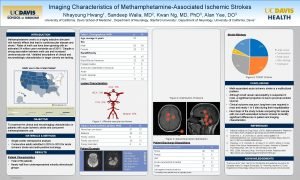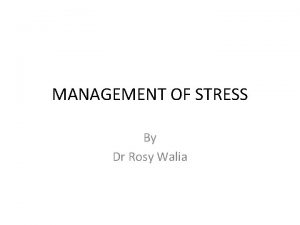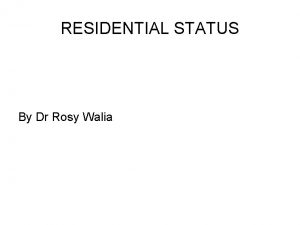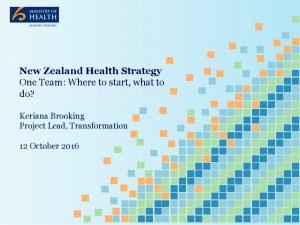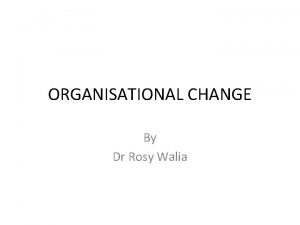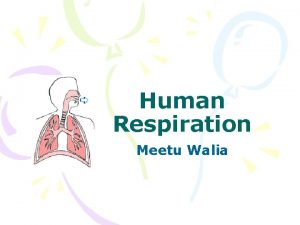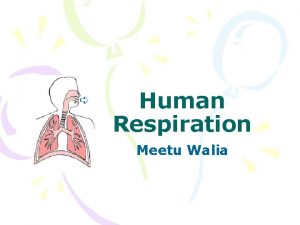Health Security for All 2016 Dr Kamini Walia





















- Slides: 21

Health Security for All 2016 Dr Kamini Walia, Division of Epidemiology and Communicable Diseases Indian Council of Medical Research

Indian Council of Medical Research (ICMR) The apex body in India for the formulation, coordination and promotion of biomedical research under Department of Health Research, Ministry of Health and Family Welfare, Government of India To undertake and support basic, epidemiological, applied and operational research in the areas of national public health importance using tools including those of modern biology Intramural research is carried out through the Council's theme oriented 33 permanent research institutes/centers and including 6 regional centers addressing to regional health problems Extramural research is done through center for advanced research, task force projects, ad hoc research schemes and fellowships in different universities, medical colleges in the country.

Bridging gaps through research • • • Research support for Polio Elimination Program Drugs trials: Malaria, Tuberculosis, Leprosy, HIV/AIDS Vaccine trials: HIV, Rotavirus, Cholera Registries: Diabetes, Cancer, Cardiovascular diseases Diagnostics: HIV/AIDS, Dengue, Malaria, Leptospira, Leishmania Guidelines: Ethics, ART Outbreak investigations Education: MPH course and numerous other specialised training courses offered by ICMR institutes http: //icmr. nic. in/About_Us/ICMR_Achievements. html

Infectious Diseases in India • Huge burden of infectious diseases – Malaria, TB, HIV/AIDS, vector borne diseases, Influenza, other outbreaks – Diarrhea, pneumonia • Sanitation conditions, malnutrition • Close animal human interface WHO Workshop on AMR: Vellore July 28 -August 1, 2014

Most recent threats • Viral infections and outbreaks – Influenza – Japanese Encephalitis – Ebola, Zika • Rising drug resistant infections “Antibiotics and anti-bacterial formulations account for nearly 18% of the pharmaceutical market, clearly demonstrating the huge supply-driven demand created by pharmaceutical companies. Recent controversies related to high levels of antibiotic drug resistance in India are a clear reflection of this induced demand”. Source: Report High Level Expert Group Report on Universal Health Coverage for India instituted by Planning Commission

VIRUS RESEARCH AND DIAGNOSTIC LABORATORY NETWORK • Timely diagnosis of these outbreaks is critical to mount appropriate public health response • Inadequacy of specialized virology laboratories in the country was noticed in the past as well as during the recent H 1 N 1 pandemic • Create infrastructure for timely identification of viruses and other agents causing morbidity significant at public health level and specifically agents causing epidemics and/or potential agents for bioterrorism. • Develop capacity for identification of novel and unknown viruses and other organisms, emerging and re-emerging viral strains and develop diagnostic kits • Provide training to health professionals • Undertake research for identification of emerging and newer genetically active/ modified agents • http: //nie. gov. in/vdln/

VIRUS RESEARCH AND DIAGNOSTIC LABORATORY NETWORK • Expenditure of 10 Regional Labs will be completely borne by the DHR/ICMR • Expenditure on State Level and Medical college Level laboratories would be shared between Central and State Government in the ratio of 75: 25 for the laboratories except NE and Hilly States for which the ratio will be 90: 10.

Management of infectious diseases is often mishandled • India has one doctor per 1700 patients • 70% of health care is dispensed through private sector • Practitioners of alternate systems • Wide urban-rural gap in the availability of medical services • Infectious disease specialists/guidelines missing link • Diagnostics under recognized underexploited tool for resistance containment

Antibiotic overuse • $12. 4 billion pharmaceutical industry • Regulations over sale of antibiotics • Over the counter availability of antibiotics • Selfprescription, inapropriapte prescribing Evolution of antibiotic resistance is a consequence of selective pressure


ICMR’s Initiative to address Antimicrobial Resistance • Creating evidence : addressing most of the WHO priority pathogens • Engaging with microbiologists, clinicians , researchers • Building a consensus through engagement with Govt funded and private hospitals • Engaging with international partners: NIH, CDC, Research Council Norway, DNDi, NIID, Japan

ICMR’s Antimicrobial Resistance Surveillance and Research Initiative • Strengthening surveillance research in AMR – Standardising the laboratory practices – SOPs for bacteriology and mycology • Stewardship activities: – – Treatment guidelines Infection control guidelines Understanding the Prescription practices Addressing the missing infectious disease link

EMERGING PICTURE OF AMR IN HOSPITALS

Comparing S. Typhi and S. Paratyphi A Susceptibility 100 90 Percentage susceptible 80 70 60 50 40 Typhi 30 Paratyphi A 20 10 ne Ce ftr ia xo cin pr of lo xa cid lid ixi Na tro m ox az c. A n Am ox ici lli l ni co ph e m lo ra ol e 0 Ci Co Ch • S. typhi multidrug resistance (MDR) : 100% sensitive to ampicillin, chloramphenicol and cotrimoxazole, cefixime • High resistance to FQ, Ciprofloxacn in S. typhi is increasingly reported

Carbapenem resistance rates in Enterobacteriaceae � Until 2005, resistance to Upto 68% carbapenem in Enterobacteriaceae had not been observed Upto 11% � 2014: it is estimated that 7 % of E coli and up to 40 % of Klebsiella Upto 4% spp resistant to carbapenem � A higher percent of susceptibility to colistin (>90%), tigecycline (up to 59%) followed by aztreonam and amikacin Upto 54% Upto 11% 44 % 55%

Non-fermenting gram negative bacilli (NFGNB) • Acinetobacter species 60% isolates, Pseudomonas species 24%, Strophomonas species 4% , Burkholderia species 4%. • A baumanii isolates showed maximum susceptibility was to colistin (99%) followed by imipenem (53%) and meropenem (53%). • Susceptibility for amikacin has increased by 23% from 2014 -2015 • All isolates of P aeruginosa were susceptible to colistin, followed by imipenem (85%), amikacin (80%), ciprofloxacin (80%), piperacillin-tazobactam (58%) and meropenem (50%) • Almost all antibiotics seems to have >70% susceptibility

Antimicrobial Stewardship Program Improve infection control Formulary restriction Prescription audits and feedback Human resource: Pharmacist, Infectious disease physicians • Hospital Informations system(HIS) • •

ICMR’s Survey of AMSP Practices 2013 • Hospital or Lab accreditations • AMSP, infection control and treatment guidelines • AMSP team: ID physician, clinical pharmacist, IT specialist, • Frequency of meetings, circulation of minutes • Anti Microbial Resistance Data Analysis • Anti Microbial Agents Usage Data Analysis • AMSP Outcome analysis

Survey of AMSP Practices 2013 • • • 20 Hospitals: 13 public and 7 private Accreditations better in private hospitals AMSP documents in 4/20 hospitals Infection control document in 20/20 Most hospitals did not have infectious disease physicians and clinical pharmacists • Anti Microbial Resistance Data Analysis 20/20 • Anti Microbial Agents Usage Data Analysis 5/20 • AMA Prescription Audit & Feedback practised by 2/20 • Comprehensive treatment guidelines missing in most hospitals • Syndrome specific guidelines frequently available • AMSP not linked with IT system in most hospitals

What needs to be done…. Drug resistant infections are increasing in hospitals Sustain quality data collection Strengthen infection control measures in hospitals Accreditations should be made mandatory Create positions for phramcists, Infectious Disease physicians • Improve diagnostics • Understand the prescribing behaviours and patient expectations • R&D for better drugs, drug combinations • • •

Role for antibiotics not limited to infectious diseases • • • VAPs, CAIs, CLBSIs Knee and Hip replacements Transplants Cancer treatments Caesarean sections
 Private securty
Private securty Mona walia
Mona walia Patroni wielkiej brytanii
Patroni wielkiej brytanii Patron wali
Patron wali Sandeep walia md
Sandeep walia md Rosy walia
Rosy walia Anubha walia
Anubha walia Kwiat walii
Kwiat walii Dr rosy
Dr rosy Name a line containing point a
Name a line containing point a Sql server 2016 security features
Sql server 2016 security features New zealand health strategy 2016
New zealand health strategy 2016 Formuö
Formuö Typiska drag för en novell
Typiska drag för en novell Nationell inriktning för artificiell intelligens
Nationell inriktning för artificiell intelligens Vad står k.r.å.k.a.n för
Vad står k.r.å.k.a.n för Varför kallas perioden 1918-1939 för mellankrigstiden?
Varför kallas perioden 1918-1939 för mellankrigstiden? En lathund för arbete med kontinuitetshantering
En lathund för arbete med kontinuitetshantering Adressändring ideell förening
Adressändring ideell förening Tidbok för yrkesförare
Tidbok för yrkesförare Anatomi organ reproduksi
Anatomi organ reproduksi Vad är densitet
Vad är densitet




